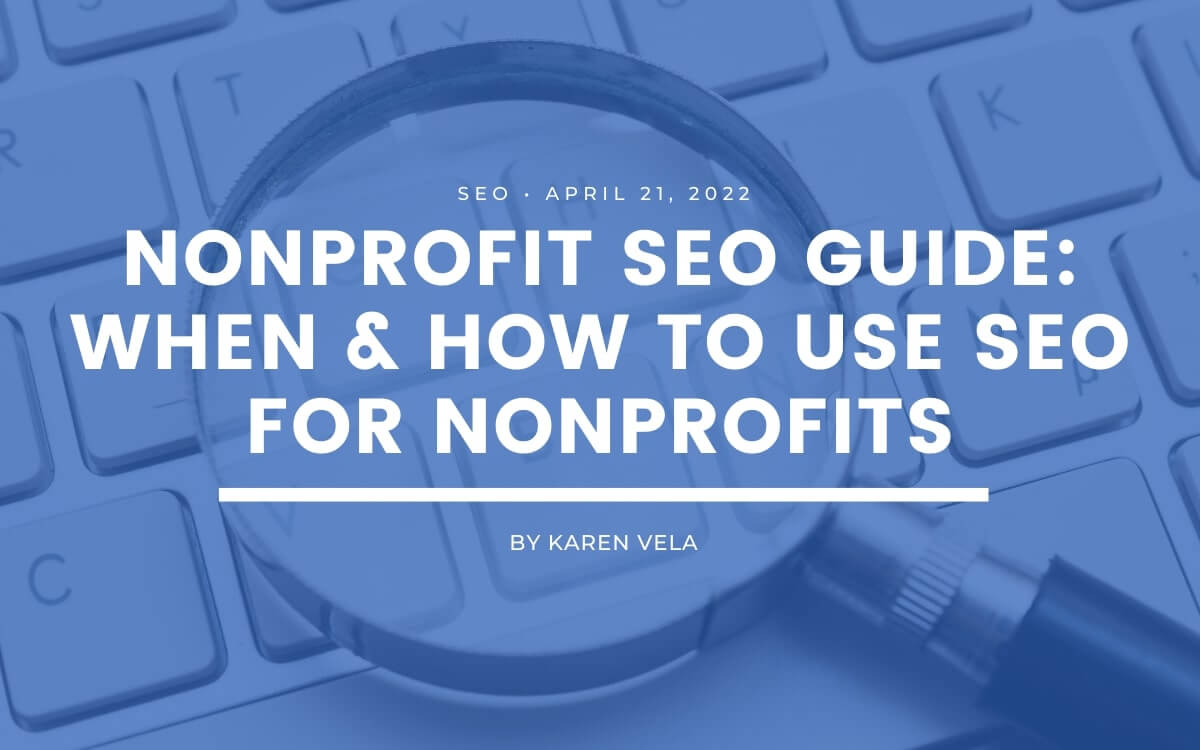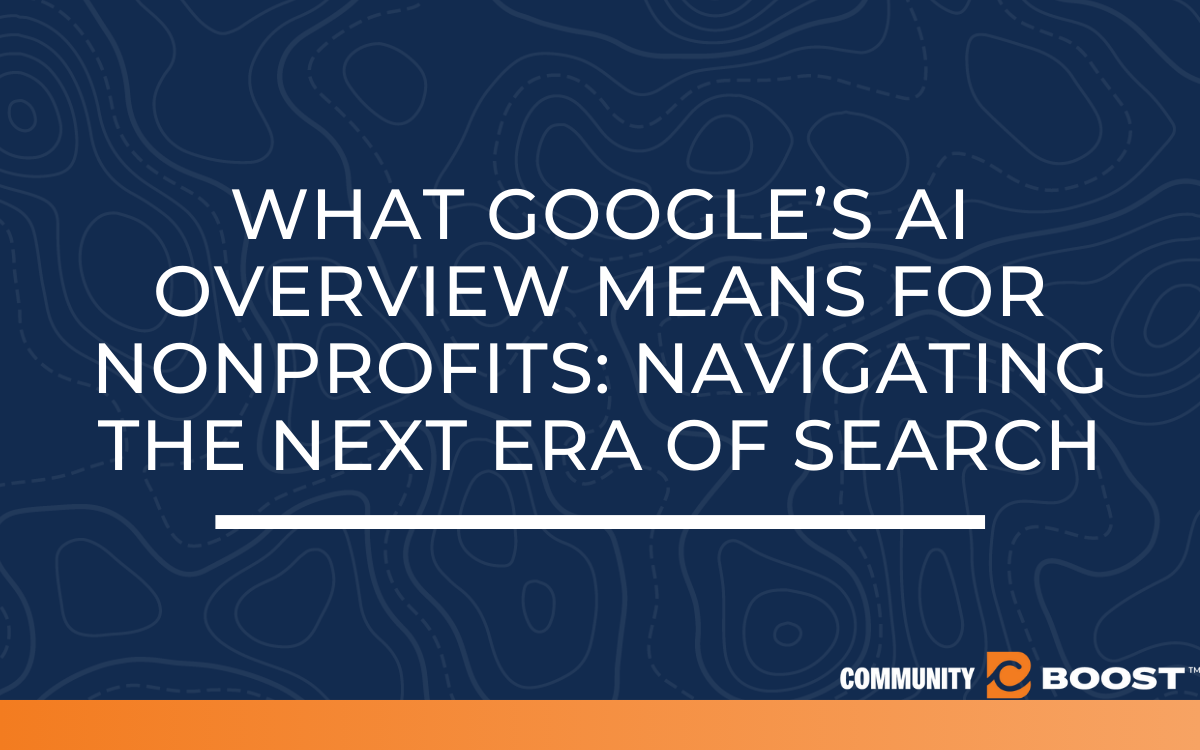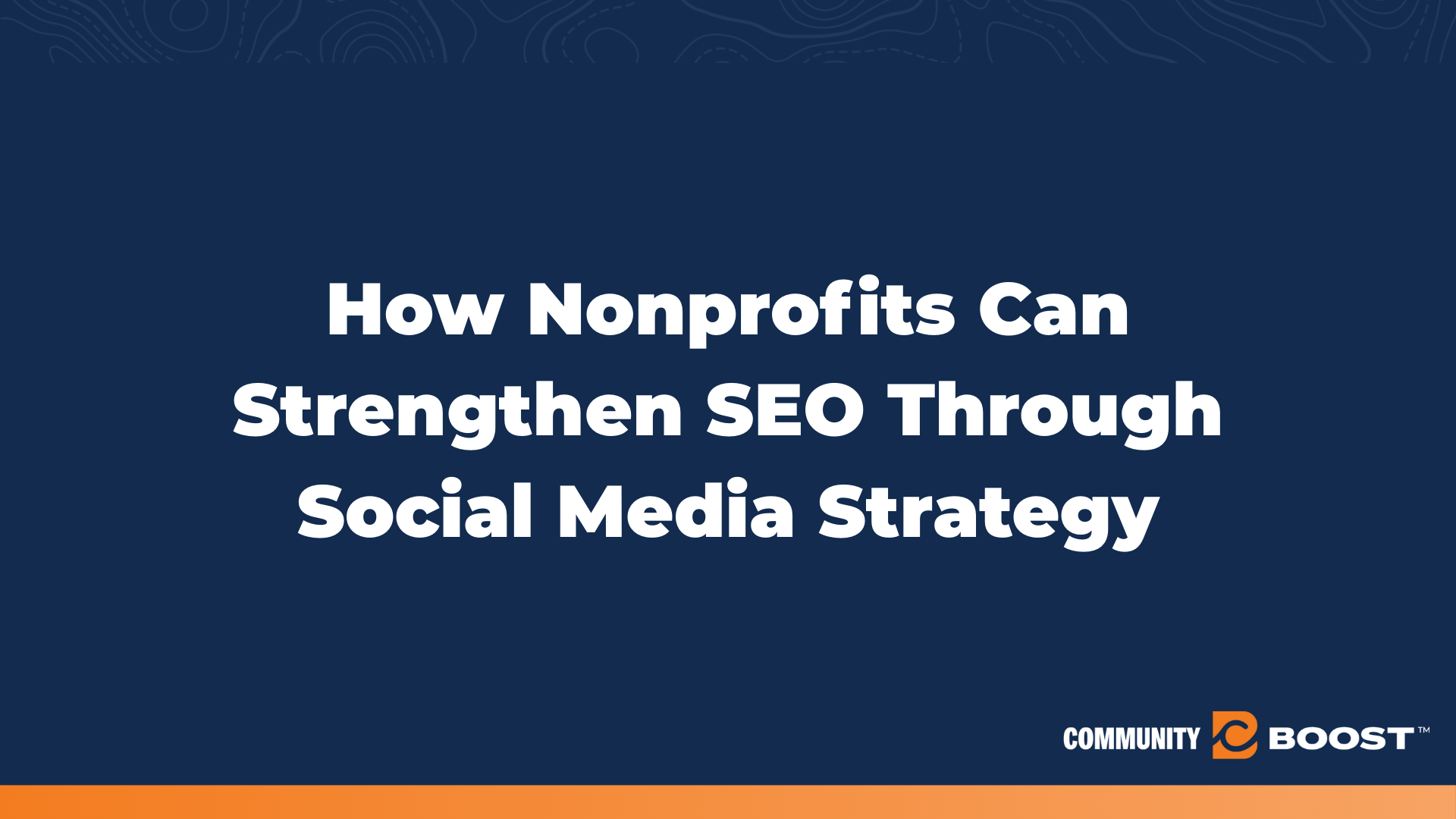Nonprofit SEO Guide: When & How To Use SEO For Nonprofits
5 min to read ✭ This guide to nonprofit SEO will provide you with foundational SEO knowledge and some actionable tips for improving rankings.
When it comes to digital marketing channels, SEO is often the most misunderstood and overlooked.
Some view it as a BS buzzword marketing agencies use to upsell them on, while others view it as something sketchy individuals sell in your DMs for $250 per month on Linked In. Unfortunately, you’re not exactly wrong if you think of SEO that way.
As the internet has evolved over the years, so have search engines like Google. As search engines have evolved, so have the tactics used for SEO.
Those changes have resulted in a world where many claiming to be experts at SEO are using methods that haven’t worked in half a decade, and where many who are considering investing in SEO struggle to identify the best path forward.
This guide to nonprofit SEO will provide the foundational knowledge needed to determine if SEO is right for your organization, along with some actionable tips for improving rankings.
Table of Contents
- What is SEO?
- What’s different about SEO for nonprofits?
- Determining if your nonprofit is ready to invest in SEO
- 10 tips for a nonprofit SEO strategy
- Working with an agency that understands nonprofits
What is SEO?
Search engine optimization (SEO) can be defined as any activities in pursuit of ranking organically in search results (SEPRs) for desirable queries and keywords. When a Google search is made, the first results displayed are usually ads that websites pay for. The next results after the ads, known as organic listings, are not earned by paying a fee to Google. Instead, the organic results you see when Googling something are there because Google believes they’re the results you wish to see for your search.
SEO is anything involving trying to increase ranking in the SERPs in order to increase organic traffic to your site.
What’s different about SEO for nonprofits?
In theory, SEO for nonprofits is no different than SEO for a for-profit business. The same methods and practices used by for-profit businesses can be adopted by nonprofits seeking to rank organically for specific desirable keywords.
The differences between SEO for different types of organizations ultimately lie in what they are hoping to accomplish.
For-profit businesses tend to have clear goals: sell a product or service at a profit. In these cases, it’s easy to justify the investment. If we use a website selling shoes as an example, they’d likely want to rank organically for searches related to buying shoes.
An investment into ecommerce SEO for this company could directly lead to an increase in revenue as a result of increased organic traffic. If they rank #1 for “buy shoes online”, they should expect to receive a large percentage of total revenue coming from organic search.
For many nonprofits, however, the motivation for increasing organic traffic might not be related to revenue at all. Instead, the investment into SEO might be to further the mission by increasing awareness or sharing information.
So while the methods used for SEO might be the same regardless of your tax-exemption status, the desired outcomes might be entirely different.
Determining if your nonprofit is ready to invest in SEO
There are over 3.5 billion searches made per year on Google alone. It’s often the first place people go to when looking for information on anything and everything. If your organization provides services or information that an individual might be searching for on the internet, it’s likely worthwhile to invest in SEO to some degree.
Of course, just because something is worthwhile doesn’t mean it should be prioritized.
The SEO strategy for a small local animal rescue will be very different from that of an international NGO. Before investing in SEO for your nonprofit, you must determine what your needs and resources are.
When a nonprofit should invest in SEO
The short answer is that if your organization or the communities you serve would benefit from being able to find your website easily from a Google search, you should consider investing in SEO.
Here are some factors to weigh when deciding whether or not to invest in SEO for your organization:
- Are the individuals or communities you serve searching for queries relevant to your organization online?
- Would your organization OR the users searching for those queries see value in finding your website specifically?
- Do you have the resources to make changes to the structure and content of your website?
- Can you afford to invest in a channel that might not see results for 6+ months?
If you answered yes to most of those questions, SEO might be a worthy marketing strategy. The question then becomes to what extent should it be invested in.
Looking to get started ASAP? Download our free guide →
SEO For Nonprofits: The Complete Guide To Ranking Higher
When a nonprofit shouldn’t invest in SEO
Just because your organization would see value in SEO doesn’t mean it should be invested in. Here are some reasons why nonprofits who are capable and willing might want to consider not investing in SEO:
- The ROI is sometimes difficult to measure, making it harder to justify to boards.
- The impact of ranking #1 organically might be relatively small compared to the level of effort it takes to get there, especially if you’re already leveraging the Google Ad Grant effectively.
- Your organization serves a very small group of people not likely to find value in discovering you online.
- You won’t be able to capitalize on the additional organic traffic to your site should your efforts succeed.
In the end, the decision usually comes down to whether or not an organization is ready for SEO, not if they’d find value in it.
For those who are unsure about whether or not they want to make a bigger commitment, the following 9 tips can be used to try and get started on your own. This is by no means “everything you’d need to know to dominate nonprofit SEO”. That could fill up an entire book.
Instead, these tips are intended to get your feet wet with SEO for your nonprofit’s website.
10 tips for a nonprofit SEO strategy
If you learn anything from this guide, it should be this:
Google’s job is ultimately to show users the best results for the searches they’re making. You can use every trick in the book to try and game the system, but none of that matters if your content sucks or if your page provides a terrible user experience.
The point is that there are no real shortcuts to SEO – at least not like there used to be. Stuffing the keyword you want to rank for 500 times at the bottom of the page no longer works, and for good reasons. That adds no value to users, so why would Google want to show that page to people searching the keyword?
Once you understand this principle, you’re ready to dive into the execution of SEO on your nonprofit’s website.
Here are 9 SEO tips nonprofits can use to get started with their SEO journey:
1. Leverage contacts and partnerships for backlinks
It’s tough to find information about SEO that doesn’t include at least some information on backlinks. Simply put, backlinks are links from an external domain pointing to a page on your website.
Consider that search engines are crawling the internet by following links from one page to another, using the anchor text and surrounding content to better understand the page being linked to. If your website has zero links to it from external sites, it’s not only harder for search engines to find, but it’ll be harder for them to judge the quality of the site as well.
With that in mind, backlinks are one of the most valuable tools in the SEO arsenal. They can also be the most difficult and time-consuming.
The best place to start when trying to build backlinks is your existing network. This could include any of the following examples:
- Organizations you frequently partner within your community
- Local news websites or bloggers who’ve run stories about your nonprofit in the past
- Former colleagues or professional connections working at other organizations
- Sister chapters of your organization
- Organizations offering ancillary services
Keep in mind, as with most things related to SEO, you never want to do it just for the sake of it. When it comes to building backlinks, this means don’t simply set out to get any link possible.
A backlink to a local food bank’s homepage from a random blog about how to roller skate isn’t likely to be very valuable. The simple test should always be “will a user clicking on this link find value in the page it’s linking to”.
If you think the answer is no, there’s a good chance Google will as well.
2. Audit your site for technical improvements that will have an impact
Technical SEO is a broad area of focus related to improvements made to the way search engines and users find, understand, and interact with a site. With an endless supply of tools and agencies offering technical SEO audits, the biggest challenge ends up being deciding how to prioritize possible improvements.
While this prioritization is entirely situational to your site’s current landscape, these are some areas that tend to have the biggest impact:
- Fixing broken internal links in your navigation or footer, where a link either redirects to a new page, or is to a page that doesn’t exist at all.
- Removing redirect chains, where Page A redirects to Page B, which redirects to Page C.
- Ensuring your Robots.txt file isn’t blocking any pages from being crawled by search engines.
- Ensuring your canonical tags are properly implemented and not preventing key pages from being indexed.
- Improving your pages site speed to decrease load time.
- Removing old, outdated, or unnecessary pages from your site to resolve index bloat.
3. Try to create the best user experience
Search engines want to show users pages that they deem most valuable and relevant based on a query.
Try Googling “best pizza in the world”, and you’re likely going to see blogs and articles listing out different restaurants and cities to get really good pizza from.
Now try Googling “best nonprofits in [your city]”, and you’ll probably see articles with similar lists.
Whatever query it is you want to rank for, you must start by understanding exactly what it is people want to see. This is equal parts art as it is science, and almost always ends in a personal judgment call.
When trying to create the best user experience based on a specific query, consider the following:
- Are people searching for general information? If so, some form of content is likely a good starting point.
- What information is most important based on the given search? It’s best to not bury the useful info at the bottom of your page, but instead provide it upfront. Think about how frustrating it is to Google a recipe, only to end up having to scroll past the author’s life story to get to the actual meat of the page.
- What other information might people find useful? Oftentimes adding links or CTAs to other pages people might find valuable can improve the UX while increasing on-page engagement.
- Are people looking to take a specific action? This could be making a donation or signing up to volunteer. Whatever it is, reducing friction between landing on your page and taking action will have benefits beyond SEO.
4. Focus on satisfying search intent above all else
Search intent is a term that gets thrown around a lot in the SEO world. While definitions vary, the meaning behind it shouldn’t.
Think of search intent as the motivation that leads to someone making a search. This might be a problem, a question, or a general curiosity they have.
Some like to think of search intent in terms of what type of page you should create, while others stick to focusing on understanding the motives behind a given search. Either way, you can’t create a page that does a great job giving a user what they want without understanding search intent.
5. Identify queries most relevant to your audience
Keyword research is one of the most important steps in forming any SEO strategy.
At its core, keyword research is the process of identifying the specific queries being searched for on the internet that your organization would find value in ranking #1 for.
There are a number of tools that help you find keywords, estimate the search volume of those keywords, and estimate how difficult it would be to rank for them. But simply finding the keywords isn’t always the hard part.
Identifying which queries are most relevant to your audience, and which will add the greatest value to your organization is usually the bigger challenge.
Here are a few tips for prioritizing the most relevant and valuable keywords:
- Form a hypothesis around which keywords are most relevant and valuable, then test your hypothesis by searching them on Google and viewing what ranks currently. You might find a keyword that means something in your industry has a completely different meaning in another, and therefore wouldn’t make sense to prioritize. Or you might find that your assumptions around search intent were incorrect, and that the page you’d create simply wouldn’t be relevant.
- Identify and use the language your target audience uses. Similar to the first point, sometimes the phrases or terminology your organization uses can differ from what more uninformed people might use to talk about a topic. Beyond looking at existing content, reading forums and sites like Reddit can help you get an understanding of the language and terms most often used by your target audience.
- See what keywords your competitors are targeting & prioritizing. Tools like Ahrefs allow you to see what keywords your competitors are ranking for organically. This can help you identify keywords that others in your space may have already validated as being relevant and valuable.
6. Create a clear keyword targeting strategy
Once you’ve identified what keywords you want to rank for, the next hurdle is deciding which pages you want to rank for which queries.
One of the biggest mistakes websites make – usually inadvertently – is creating multiple pages targeting the same keyword.
This mistake is known as keyword cannibalization, and it happens when 2 or more pages are competing for the same keyword(s) on a website.
As a general best practice, each unique keyword or group of keywords shouldn’t be targeted by more than one page.
A complete content audit of your site – where you identify each page, the purpose it serves, and the topic it relates to – is the first step in creating a clear keyword targeting strategy.
From there you can identify what pages you want to rank for what keywords in order to optimize each page accordingly and resolve any possible cannibalization.
7. Start creating and publishing high-quality content
Now that you’ve identified queries that are relevant to your audience, and done keyword research to identify the best terms to rank for it’s time to start creating some content. Consistently writing and publishing content on your blog can help your website rank for keywords that your audience might be searching for.
In order to make sure your content is going to perform to the best of its ability, we recommend starting with a content brief. Here’s a free step-by-step guide to creating a content brief, plus a blank content brief template you can adopt into your own strategy.
8. Get analytical with Google Analytics and Google Search Console
Google has two free tools for understanding your site’s traffic and search performance that every site should be utilizing.
Google Analytics (GA) allows you to track, measure, and analyze the traffic coming through your website. Whether it’s organic traffic from google, or traffic from users clicking on links in a newsletter, GA provides valuable information on which pages people are landing on, how they’re getting there, and what they’re doing once on the page.
Google Search Console (GSC) allows you to analyze and understand your website’s search performance in Google. You can see everything from what specific queries are getting clicks in Google, to how your pages perform on mobile devices.
At the very least, it’s worth investing time into understanding how to use both GA and GSC if you plan on doing SEO yourself. If not, and if you’re planning on partnering with an SEO agency, it’s almost certain they’ll request GA and GSC access to your site, so the sooner you get them set up the better!
9. Weave SEO holistically into your digital marketing strategy
If you can’t tell by now, SEO is a complicated field. Partially due to its difficult nature, and partially due to the evolution of tactics over the years, many people prefer to ignore SEO altogether.
For those who do decide to pursue SEO, a common yet fatal mistake is assuming it’s something that occurs after the fact and behind the scenes. This couldn’t be farther from the truth – at least not if you want to succeed long term.
Consider the following scenario.
A local museum decides to hire an SEO agency, with a top goal being to rank #1 for “local children’s museum”. That agency spends the next few months auditing the site, making technical cleanups, and forming a strong keyword targeting strategy.
In doing so, the agency identifies an existing landing page as the one they want to target for the query “local children’s museum”. They spend countless hours optimizing the page for the term, building backlinks to it, and adding new internal links to the page from other pieces of content.
All is going well, with the museum jumping to the 3rd spot organically for the target keyword.
Meanwhile, the digital marketing department has published 10 new blog pages on their own, outside the perceived scope of SEO. Of those 10 pages, 3 are stories about children interacting with different exhibits at their museum; each with the keyword “Children’s Museum” in the title, and within anchor text used to link to each other.
Without knowing it, the marketing department may have caused minor keyword cannibalization that could go entirely unnoticed. Even further, some of the content they created might have been valuable for SEO had it been considered from the start.
Holistic SEO happens when the underlying principles and best practices are baked into every area of the organization from the start. This means building a structurally sound website from day one, as well as understanding how local PR can provide easy opportunities to earn backlinks.
Having SEO as an afterthought leads to avoidable mistakes and missed opportunities. This doesn’t mean your entire team needs to be SEO experts, just that if you do decide to invest in SEO, don’t shove it into a corner with no insights into the rest of the organization and its operations.
10. Give it time
Successful SEO is a marathon, not a sprint. For budget-constrained nonprofits beholden to board members & the communities they serve, marketing initiatives that won’t see a return on investment for a long period of time are often deprioritized or ignored altogether.
And that’s fine.
What isn’t fine is investing in SEO and expecting immediate results. Sure, you can often see some quick wins in the early stages of your efforts, but you shouldn’t expect to.
This is one of the biggest challenges in making the leap to SEO. Many agencies sell SEO as a one-time investment or something that can be turned on and off like paid ads. This just isn’t the case.
Make any Google search for a query you assume would be difficult to rank for and look at the top results. It’s almost guaranteed that those sites have been investing in SEO to some degree for a long period of time.
Working with an agency that understands nonprofits
Over the last 10 years, Community Boost has directly served over 1000 forward-thinking nonprofits of all sizes and sectors and directly raised over $100M in online revenue to scale impact. You could say we know a thing or two about nonprofit digital marketing! Check out how we helped our client, Quality Start San Bernardino, increase their organic traffic on Google by 25%!
We currently offer SEO services that are customized to best fit your nonprofit’s needs. Just because you read this far, click here to get a free 1:1 SEO strategy session with one of our experts.
Want immediate strategy assistance? Download our free guide! SEO For Nonprofits: The Complete Guide To Ranking Higher.





